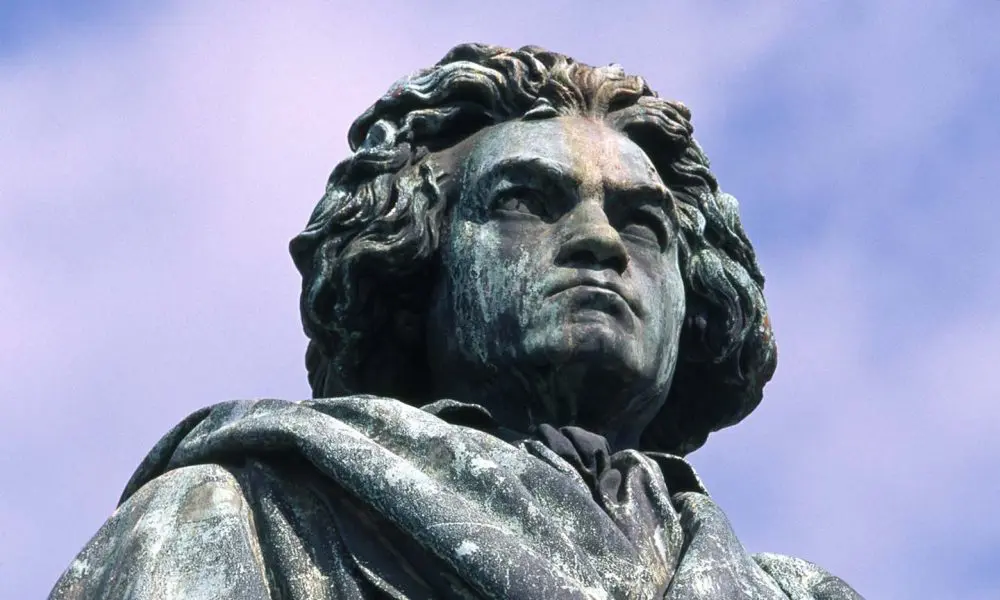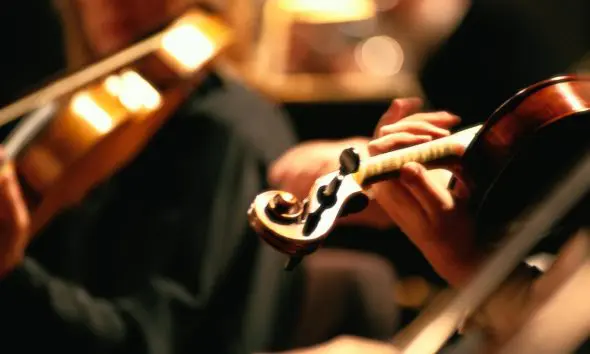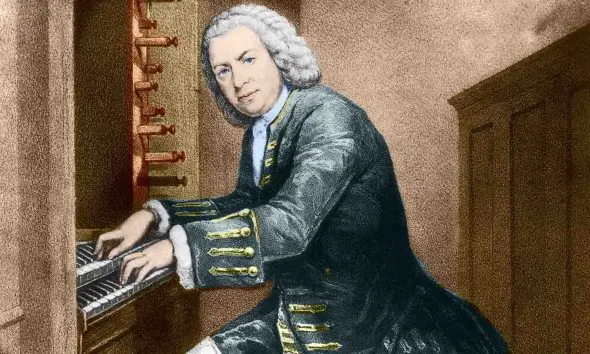reDiscover Beethoven’s ‘Choral’ Symphony No. 9
Discover the story behind Beethoven’s ‘Symphony No. 9’, also known as the ‘Choral’ Symphony, one of the greatest symphonies ever composed.

Beethoven’s Symphony No. 9 in D minor, Op. 125, is widely regarded as one of Beethoven’s greatest compositions and one of the greatest symphonies ever composed. Symphony No. 9 is also known as the ‘Choral’ Symphony as its final movement features four vocal soloists and a chorus who sing a setting of Schiller’s poem An Die Freude (Ode To Joy). Beethoven steadily lost his hearing while writing the symphony and was profoundly deaf when it was premiered on May 7, 1824. Scroll down to discover the story behind Beethoven’s Symphony No.9 – the ‘Choral’ Symphony that rewrote the classical rules.
Listen to our recommended recording of Beethoven’s Symphony No. 9, performed by the Berlin Philharmonic conducted by Herbert von Karajan, on Apple Music and Spotify.
Why the name?
Beethoven’s Symphony No. 9 is also known as the ‘Choral’ Symphony because Beethoven took the highly unorthodox step of writing the fourth movement for four vocal soloists and a chorus, setting parts of Schiller’s uplifting poem An Die Freude (Ode To Joy), which has as its theme the universal brotherhood of mankind.
Need to know
The symphony was commissioned by the Philharmonic Society of London in 1823 for £50 even though, six years earlier, Beethoven had failed to deliver on another symphony commission. London even missed out on the premiere, which was held in Vienna on 7 May 1824, but the British premiere was given on 21 March 1825 at the Argyll Rooms in London and a blue plaque, put up by the Royal Philharmonic Society, marks the spot. Still proud of their coup, the RPS continues to commission established and new composers today.
Sadly for Beethoven, the extraordinary expense of orchestra, chorus, and soloists ensured that profits were minimal, and he was still unable to pay off his debts.
Beethoven was too deaf to conduct Symphony No. 9 by the time it gained international fame. At the Viennese premiere, he sat at the side of the stage to give the beat. By the end, he was several bars behind the orchestra and didn’t notice that the audience was giving him a standing ovation until the contralto, Carolina Unger, gently turned him round to face his public.
In the ‘Choral’ symphony, Beethoven took the structure of a Classical symphony to its limits in an expression of his lofty philosophical theme: the unity of mankind and our place in the universe. While it appears to follow a conventional four-movement symphonic model, its massive choral fourth movement was not at all conventional. It opens with a recap of each of the previous movements’ themes, but then Beethoven seems to reject them all, in the phrase he writes for the bass soloist, “O friends, not these sounds: rather let us intone pleasanter and more joyful ones”. The bass then sings the main theme of Ode To Joy, with interjections from the chorus.
Beethoven’s ‘Choral’ symphony became a source of inspiration to composers who followed, and a keystone of the 19th-century Romantic movement. Brahms, was accused of lifting the Ode To Joy theme for a related theme in the finale of his First Symphony (“Any fool can see that!” he retorted, unabashed). And Wagner described it as, “The redemption of Music from out of her own particular element into the realm of universal Art.” The scale and ambition of Beethoven’s Symphony No. 9 also opened the floodgates to the grand and spacious symphonies of composers like Bruckner, Liszt, and Mahler.
A powerful message of hope and unity
The symphony continues to be used as a powerful message of hope and unity. In 1951 Wilhelm Furtwängler and the Bayreuth Festival Orchestra reopened the Bayreuth Festival with a performance of the symphony, after the Allies temporarily suspended the Festival following the Second World War. And to celebrate the fall of the Berlin Wall in 1989 Leonard Bernstein conducted a legendary performance of Beethoven’s Symphony No. 9, featuring musicians from both German States and the four Occupying Power States of post-war Berlin in the orchestra, by the Brandenburg Gate. Significantly the words from Schiller’s Ode An Die Freude (Ode To Joy) were changed: the word ‘Freude’ (Joy) became ‘Freiheit’ (Freedom).
Can I play it?
Maybe not, if you don’t play an orchestral instrument, but singers may be able to muscle in on the fourth movement. But be warned: the choral movement is punishing for the singers, especially the sopranos, who have to sing on top As for bar after bar. Beethoven was not concerned about the vocal comfort of his singers.
Where have I heard it before?
Beethoven’s ‘Choral’ Symphony No. 9 is still one of the most frequently played orchestral works in the world. It’s an annual fixture at the BBC Proms, traditionally on the penultimate night of the season, and is one of the most requested works on the BBC’s Desert Island Discs.
Ode To Joy is also a favorite New Year’s Day singalong all around the world and played at many Olympics opening and closing ceremonies. And no round-up is complete without The Muppets’ version of Ode To Joy.
Best recordings
From the 1960s to the 1980s, Karajan and the Berlin Philharmonic’s recordings of the Beethoven symphonies were the gold standard for a generation. Karajan recorded Beethoven’s Symphony No. 9, three times in stereo, his 1977 recording is perhaps the best of the three. He captured the power and grandeur of Beethoven’s sublime conception with huge energy, and the soloists, Anna Tomowa-Sintow, Agnes Baltsa, Peter Schreier and Jose van Dam are excellent both individually and as a team.





Mario
May 27, 2022 at 9:54 pm
Karajan’s interpretation of Beethoven’s 9th Symphony is … okay, but my favorite is Leonard Bernstein’s recording in the 70’s. That is a beautiful and powerful Symphony No. 9. The New York Philharmonic and Bernstein were at the top of their game then. The album cover is black with Leonard’s photo conducting the Philharmonic. Karajan has nothing on Leonard Bernstein.